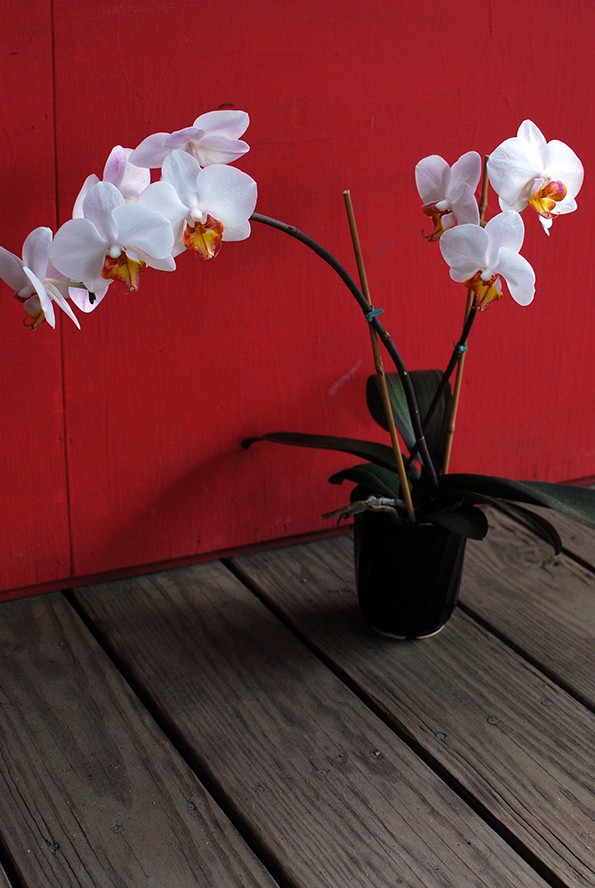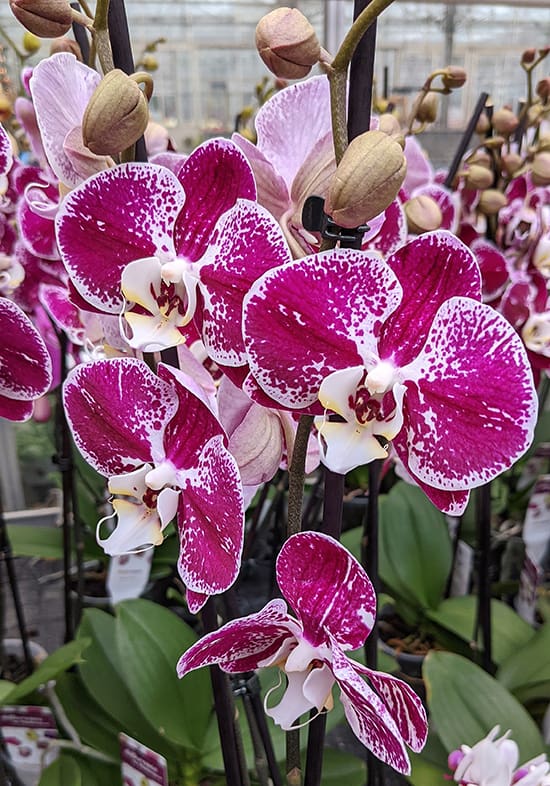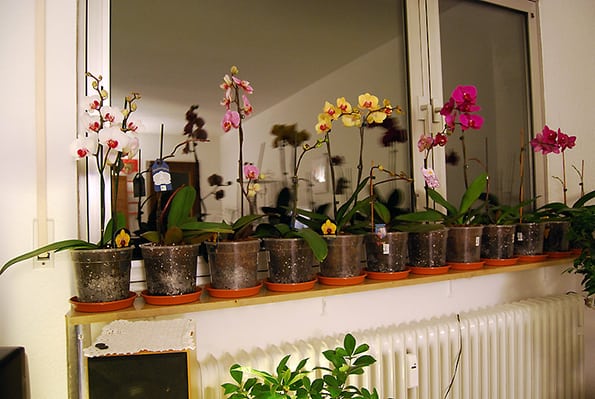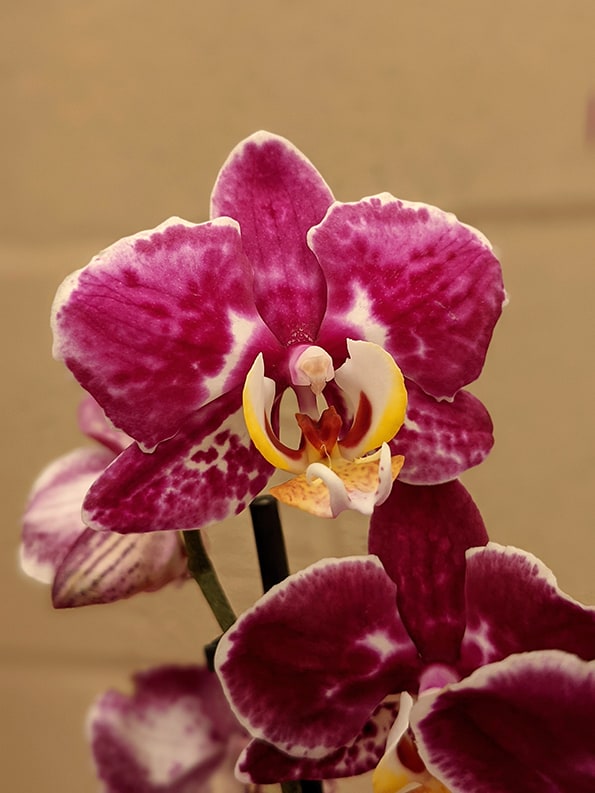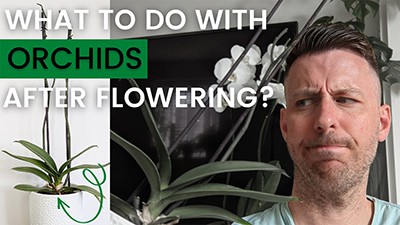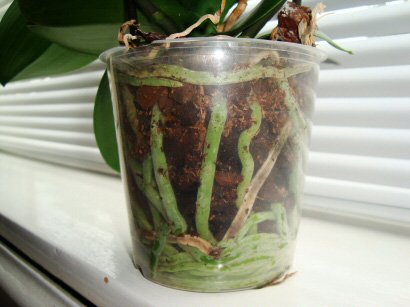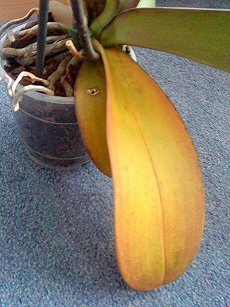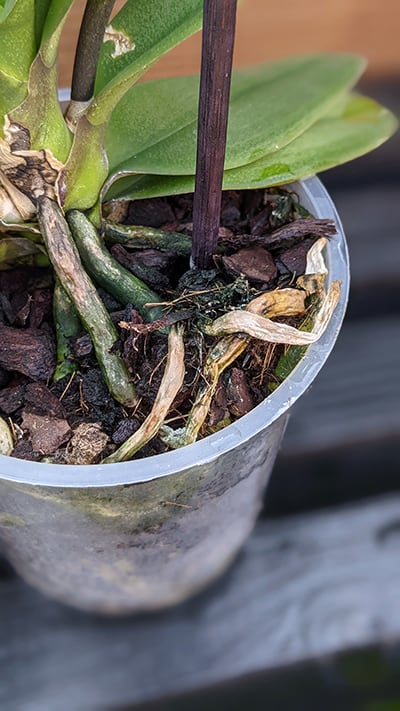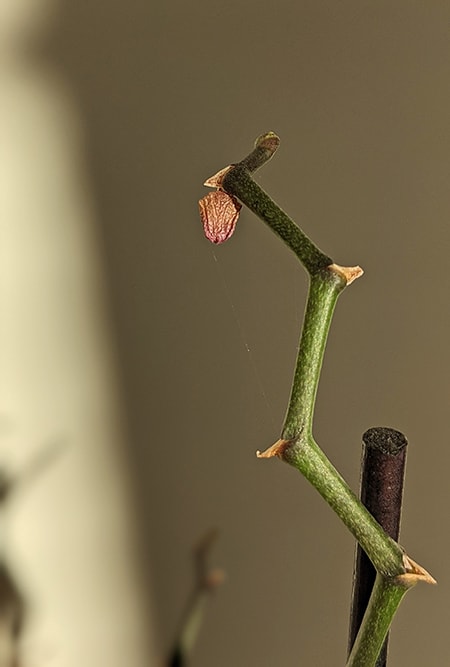The Moth Orchid, Phalaenopsis Orchid or "Phal's" are very well known houseplants and easily recognised today. They don't need a great deal of care and can look gorgeous for months on end.
They've arguably also done more to raise the popularity of orchids in general than any other genus and are readily available.
Although exotic looking, this is one houseplant that doesn't need humid environments or complicated care to thrive indoors. Photo by - slgckgc
Around 25 years ago, Moth Orchids (along with other orchid species) were admired but considered only suitable for those with conservatories and wealth, such a plant was an indulgence most couldn't afford.
Then several hybrids were created, which allowed mass propagation to occur. Before long, they were being shipped worldwide and as their popularity grew, more and more people wanted one. They now pop up everywhere, from supermarkets to garage forecourts, and it's easy to see why.
The Phalaenopsis genus is one of the easiest orchids for beginners to care for, simple to rebloom and are reasonably priced. They're ideally suited to the home environment, with a preference for warm conditions and medium light levels, which occurs in at least a few rooms of every home.
How do you pronounce Phalaenopsis correctly? Say:
fal-ih-NOP-sis
The flowers are remarkably numerous, unusual but pleasing and very long lasting, coming in an almost limitless number of colors and patterns. The common name of "Moth Orchid" derives from the shape of the flower which resembles a Moth in flight.
A slight drawback of all this hybridising means some Moth Orchids will be almost in constant flower, which is beautiful to look at but comes at the plant's expense.
As it spends all of its energy producing new flower spikes instead of new growth it means the plant can be quite short lived when compared to other houseplants.
The "Moth Orchid" name comes from the shape of the flower which looks like a moth in flight
There are hundreds of different looking Moth Orchid plants with various names on the labels or No ID (no identification). But almost all Moth Orchids have similar growth patterns, so for the everyday fan, it's just best to pick the plant with the colors or markings you enjoy the most.
It's time to move on and tackle the Phalaenopsis Orchid care instructions and keep your plant looking its best.

Hi, I'm Tom!
If you're like me and enjoy the challenge of growing houseplants and getting them to thrive, then Ourhouseplants can help. This website shares my knowledge and years of growing plants and provides (hopefully) helpful advice on properly caring for your indoor plant friends.
Fairly bright light is required for a Phalaenopsis plant, especially if you want it to rebloom. But absolutely no direct sunlight or the leaves will scorch from too much light and heat hitting the leaves.
Indirect light coming from an East, South, or West facing window would be Okay, providing the plant is set into the room or the window is partly shielded from, say, blinds or a sheer curtain .
Your orchid must never "sit" in water. It will need frequent watering, perhaps once or twice a week in very hot months of the year and less in colder ones.
For everyday watering, it's fine to run them under the tap for 30 seconds. The water will flush out of the bottom quickly, but the roots will still grab hold of the moisture as it falls through the potting mix.
You can occasionally dunk the pots in a bowl of tepid water for a few minutes to give them a good soak. I try and do this at least bi-monthly and when I do, I add a bit of fertilizer to the water.
Whichever method you use, try and prevent water from splashing on the leaves as this can encourage the bacterial disease Brown Spot and Erwinia infections.
Did You Know?
The aerial roots outside of the pot will always be silver unless the humidity is high or you mist them.
If you need some help knowing when to water your Moth Orchid, assuming the plant is in a clear pot (see the Anything else section below) you can look at the roots for hints.
When the plant is dry and needs water, roots within the pot and any aerial roots will be very light green or silvery. A minute or so after watering, the roots will transform from faded and silver to a vivid green color.
This green will fade and go silvery again once dry. Moth Orchids do benefit from a wet to dry cycle, so try and wait for this to happen before reaching for the watering can again.
Orchid roots before and after watering.
To see how the roots change in the presence of water use the slider in the above photo to move or tap back and forwards. I also soaked the aerial roots for this photo so you can see how they change from silver to green.
I also have a full guide including a simple quiz to give you a more detailed response about how often you should water orchid plants.
Further reading -
Should you Water your Orchid's with Ice Cubes?
High humidity will decrease the watering frequency, and it's essential if the plant is perhaps attached to a "mount" instead of sitting in a pot. Otherwise, you won't need to worry too much about humidity levels unless you have very dry air.
A Phalaenopsis is an epiphytic orchid, so it's adapted to receiving occasional low levels of nutrients. In other words, it's not a heavy feeder so feeding every few months will be more than adequate.
You can get unique Orchid feeds. However most are essentially weak versions of all-purpose houseplant fertilizers. If you want to save money or keep things simple, you can get away with using an all-purpose feed at low strength.
The plant needs a warm spot, 16°C (61°F) - 27°C (81°F). Traditional wisdom states to get new flower spikes, you need to have a high daytime temperature and a low nighttime temperature i.e. a large "swing".
However, experiments have shown that a room that stays reasonably warm during the day and at night, which does not exceed 27°C (81°F), will still trigger new flower spikes.
Positioning up close to North Facing Windows can be a good spot for a healthy Orchid collection.
Photo by Ting Chen
Moth Orchids usually come (and should be kept) in a potting mix that is very "airy". Typically orchid bark or fir bark is used, but anything which holds small amounts of water and minerals would be acceptable.
I've seen them growing in sphagnum moss too. This isn't something I personally grow mine in as I like to keep things as simple as possible. The Sphagnum moss is alive and needs care, too, as it will easily go brown if underwatered.
Important
Never use standard potting compost or peat moss based mixes. This growing medium holds too much water and the roots will quickly rot.
Repotting only needs doing when the bark or potting mix has broken down, or the plant "pushes" itself up and out of the planter. This could be anything from 2 to 3 years.
The best soil for orchids will be the special orchid potting mixes available from many places, especially larger garden centers or big box stores.
These have a high bark content to help keep the growing medium open and allow for good drainage. They can be specialist and a little difficult to find, but if you're struggling, there's always Amazon.
When it comes to repotting all you need to do is release the plant from its current container (you may have to cut off some of the roots if they have escaped out of the drainage holes and hooked on), and shake off the old potting mix.
Look for any dead roots, which will be thin like paper, black or mushy and cut them away. Then replace the old potting medium you removed with the new. It's just a case then of gently "pushing" the plant back into the planter.
If the Orchid hasn't been repotted for years or it has drastically pushed out of the container, you may have to consider moving to a new planter one size up. This isn't always necessary as the root systems tend to be more modest than other houseplants.
If the above doesn't make sense or you're having problems check out this video over at the American Orchid Society.
Orchids are propagated by seed, however this method isn't for the average owner because it's expensive and time consuming. It's normally more cost effective to increase your collection by going out and buying more.
You can sometimes get bargain plants when the flower display is almost over, sellers don't want to wait for the next bloom cycle so they discount heavily. If you follow our guide, you can get your Orchid to bloom for you again in no time.
Periodically the plant will naturally produce "baby" orchids known as keiki's, these are identical copies of the parent and typically appear on either an old or new flower spike.
New plants appear on a flower stem. Photo by Maja Dumat - Creative Commons License BY 2.0
Once it's old enough you can remove the keiki from the parent and pot up in its own pot. Bear in mind it can take a year or more before the keiki can be separated.
It will be ready when the new plant has 2 or 3 leaves and several roots, the largest about 3 inches long.
Slow. A mature Moth Orchid can expect to grow 1 to 3 new leaves a year with an equal number of lower leaves yellowing and dropping off.
The number of flower spikes and the frequency you get them during the year will vary depending on the plant itself and the growing conditions.
The plant will normally reach up to 20cm / 8in in height and about 30cm / 12 in spread. Yet, the flower stems can reach unbelievable lengths. Use houseplant sticks to support very long stems.
If you provide the growing conditions detailed above your Moth Orchid should produce several flushes of flowers each year. If you become a fan of these orchids and you amass a collection, you'll notice they have their own personalities.
With the right conditions and enough light, Phalaenopsis Orchids could flower at any time of year and they'll last a long time.
Some will produce several flower spikes at once, some will have just one stem at a time, and others will continue extending the same spike over and over until it becomes incredibly long.
If yours is a particular favorite, ensure it has at least four leaves before allowing it to flower. If you notice a flowering spike starting and the plant has seen better days cut the spike off to encourage new leaf growth first.
I've written an article, including a video, which answers this in full and gives you the choice of four options to help get your Moth Orchid reflowering in no time.
Check out our What to do with Orchids After they Bloom article if you need help.
Moth Orchids are not poisonous or toxic to cats, dogs or people.
No. Very few plants have naturally blue flowers, which is also true of Moth Orchids. When you buy them in store they're actually a white variety that's been dyed prior to sale. You can read more about Blue Orchids in my seperate article.
They stay blue, but in the future, when you get new buds and blooms, they'll revert back to their natural coloring.
There are two general viewpoints about what planter the plant should be placed in. Either clear plastic ones or just use regular containers.
Clear Plastic
As well as being pretty, the roots contain chlorophyll, so photosynthesis occurs here as well as in the leathery leaves.
A see through container will let light reach the roots. Light equals more photosynthesis which in turn means a more robust plant and a greater probability of flowers.
Using a clear pot best reflects the conditions of orchids growing in their natural habitat. These containers will also show you the roots at all times and allows you to judge when it's time to water. There are more advantages to using them which I go into here.
Green roots of a Moth Orchid in a clear plastic pot.
Normal Plant Container
The plant will adapt if light doesn't reach its roots. The adaptation will often result in the leaves becoming a slightly darker green and producing more leaves than a plant in a clear planter.
Overwatering is a common problem when you can't see the roots. So I personally recommend clear containers where possible especially for less experienced owners.
Large black, brown splotches on the leaves.
(In order of likeliness):
My Orchid has yellow leaves.
One of the reasons Moth Orchids don't tend to get very large is because whenever it produces a new leaf, an older one gradually turns yellow and then falls off. In view of this, yellow leaves are sometimes perfectly normal.
If there are more yellow leaves than new ones forming and you're not doing it already, it could be time to feed. Check in on your watering technique as yellowing leaves can occasionally be a symptom of overwatering.
Moth orchid with yellow leaves
Large wet patches on leaves.
This is likely a bacterial disease, perhaps Brown Spot, Black Rot, or an Erwinia infection. You can prevent it by not wetting the leaves or the plant's crown when you water it.
Once set in, there isn't much you can do other than remove the affected leaves. Discard the plant if it's terrible or if you have other Orchids nearby.
Unhealthy, few leaves, but still pushing up flower spikes.
Sometimes Moth Orchids will spend their final energy reserves flowering if you let them. If you'd rather the plant try to save itself, ensure conditions are favorable, and remove the new flowering spike and any further ones the plant produces until health is restored.
Consider that even this may not work, some Moth Orchids will have short life spans after they start flowering (5 years or less) no matter what you do.
Wrinkling Orchid Leaves.
In most cases this is down to underwatering. It could be easily fixed by just increasing the frequency that you water your plant.
On the other hand it could be more complicated. Check the roots if most are brown, black, mushy or missing then your plant isn't able to absorb enough water which is causing the wrinkling. See the next problem for more information.
No roots.
Almost always caused by overwatering at some point previously. This is quite a feat when the potting mix is so free draining.
The problem is normally caused by the use of drip trays or containers which in some way prevent water from actually draining away. 30 minutes after watering you must empty the drip tray or the container if it's still holding water.
Orchids are not like normal houseplants when it comes to watering.
Orchids are not like normal houseplants, while they do need water regularly, they must have air surrounding their roots and water being there instead of the air on a regular basis is not a good thing. In fact it's positively fatal in most cases. Spot the dying roots early enough and the orchid will re grow new roots.
Unhealthy / White Empty Orchid roots.
Some roots go like this with age. Others, when the plant is allowed to be dry for long periods (underwatering) or in some rarer cases, it can be caused by overwatering. Very dry air (low humidity) over long periods can make the aerial roots brittle. Try and water them a little each time when watering the potting mix.
Those white roots towards the right side of the pot are finished and should be removed. Those towards the base of the plant are normal and should be left alone.
Once the roots have gone like this they're basically adding nothing to your orchid and could even encourage plant diseases or pests, so snip them off and remove.
Water drains out of the pot too quickly.
To be expected with a loose potting mix. If you don't feel the roots have enough access to water, dunk the pot into a larger container/bucket of tepid water for a few minutes. This will allow more time for the water to soak into the potting mix.
No Flowers on my Moth Orchid.
To get your Moth Orchid to reflower follow these instructions to encourage new blooms.
Orchid Bud Blast / Bud Drop.
This is seen in new buds (not ones that have already open) the symptoms of which are the buds withering, yellowing and dropping off. There are many causes. Consider which is the most probable and resolve for when the orchid next blooms.
Phalaenopsis orchid bud blast
Pests on the Orchid or in the potting mix.
Some pests like Woodlice and Springtails love decaying plant matter such as bark. When you water, both of these pests will be more noticeable as the water will trigger them to move above.
The good news is that neither will directly harm the plant, instead they feed on the decaying material in the potting mix.
Scale and Aphids can sometimes take hold on Moth Orchids, if the care being provided isn't too good and it's weakened the plant. Easily treated though, check out our pest guide for details.
(Gallery) Photo credit of the Light Pink and Dark Purple Moth Orchid to Guillaume Paumier, CC-BY
